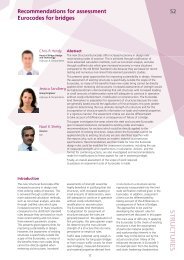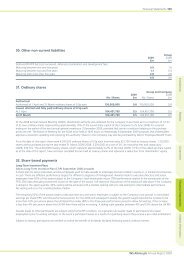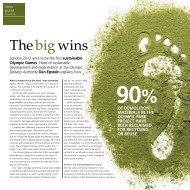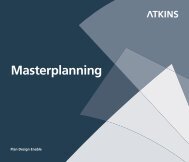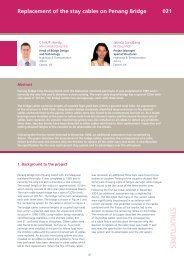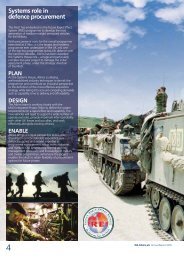View - Atkins
View - Atkins
View - Atkins
Create successful ePaper yourself
Turn your PDF publications into a flip-book with our unique Google optimized e-Paper software.
76 Financial Statements<br />
Notes to the Financial Statements<br />
Continued<br />
The Group’s primary exposure to foreign exchange rate risk on unhedged financial instruments arises mainly in respect of movements<br />
between the US dollar (including dollar-pegged currencies) and sterling and between the euro and sterling. At 31 March 2008, if sterling<br />
had strengthened/weakened by 9% against the US dollar then profit after tax would be lower/higher by approximately £0.3m (2007: £0.2m)<br />
and equity would be £0.3m lower/higher (2007: £0.2m). If sterling had strengthened/weakened by 20% against the euro then profit<br />
after tax would be lower/higher by approximately £1.3m (2007: £0.4m) and equity would be £1.3m lower/higher (2007: £0.4m).<br />
The Group’s investments in foreign operations are subject to foreign currency translation risk. A proportion of this risk has been<br />
managed by taking out foreign currency loans in the relevant currency and, in one instance, by maintaining a substantial sterling bank<br />
account balance in the local business. Following a review of hedging policy undertaken during the year, it was decided not to hedge<br />
the Group’s net investment in foreign operations and as a consequence the foreign currency loans were repaid.<br />
ii) Interest rate risk<br />
The Group’s exposure to interest rate risk arises from loan notes, cash and cash equivalents and financial assets at fair value through<br />
profit or loss which are all interest bearing, offset in part by interest bearing borrowings. The majority of items included in the above are<br />
at floating rates of interest or fixed deposits for periods of less than six months; changes in the interest rate result in changes in interest<br />
related cash flow. No interest rate hedging is currently undertaken by the Group or its subsidiaries. If interest rates for the year to<br />
31 March 2008 were 10 basis points higher/lower, then profit after tax for the year would have been approximately £0.1m<br />
(2007: £0.1m) higher/lower, principally due to increased interest received on short-term bank deposits.<br />
iii) Price risk<br />
The Group does not have any equity securities in its balance sheet and is not materially exposed to commodity price risk. Certain longer<br />
term project and framework contracts include indexation clauses that are applied to unit rates to offset the effect of inflation on input<br />
costs over the duration of the agreement. The Group is exposed to price risk to the extent that inflation differs from the index used and<br />
forecast project outcomes that form the basis of revenue recognition include an estimate of this risk where it is present.<br />
b) Credit risk<br />
Credit risk is the risk that the Group will suffer financial loss as a result of counterparties defaulting on their contractual obligations. The<br />
risk arises on financial instruments at fair value through profit or loss, cash and cash equivalents and trade and other receivables, with<br />
the maximum exposure to risk equivalent to 100% of the carrying value disclosed in the Group’s balance sheet at 31 March. The Group<br />
does not hold any collateral as security. The majority of the Group’s cash deposits are placed with its relationship banks, which carry at<br />
least an AA credit rating. For deposits and money-market investments placed with banks and financial institutions, only independently<br />
rated parties with a minimum rating of A are accepted. Investments carry a minimum credit rating of A1/P1. Cash and investments are<br />
not concentrated with any one counterparty.<br />
For trade and other receivables, an assessment of credit quality of the customer is made where appropriate using a combination of<br />
external rating agencies, past experience and other factors. In circumstances where credit information is unavailable or poor, the risk<br />
is mitigated by use of advance payments and, by exception, through credit risk insurance. Group policy is not to apply individual credit<br />
limits, although exposure and payment performance are monitored closely both at individual project and client level, with a series of<br />
escalating debt recovery actions taken where necessary. The Group’s customer base is broad and dispersed; there are no concentrations<br />
of credit risk that would cause concern.<br />
c) Liquidity risk<br />
The Group funds its activities through cash generated from its operations and, where necessary, bank borrowings and finance leases.<br />
The Group’s banking facilities include cash facilities and bank guarantees. Cash flow forecasts are prepared covering various periods<br />
from short to long-term to ensure that sufficient funds are available to meet the Group’s commitments as they fall due.<br />
The table below analyses the maturity profile of the Group’s non-derivative financial liabilities. Figures shown are undiscounted.<br />
On demand Between Between<br />
or within 1 and 2 and Over 5 Carrying<br />
2008 1 year 2 years 5 years years Discount value<br />
Hire purchase and finance leases 4.4 4.7 5.3 1.8 (2.2) 14.0<br />
Loan notes 4.3 2.9 0.7 – (0.5) 7.4<br />
Trade payables 52.0 – – – – 52.0<br />
On demand Between Between<br />
or within 1 and 2 and Over 5 Carrying<br />
2007 1 year 2 years 5 years years Discount value<br />
Bank loans – 17.3 – – – 17.3<br />
Hire purchase and finance leases 3.9 4.6 8.1 0.4 (2.3) 14.7<br />
Loan notes 0.4 2.7 3.1 – – 6.2<br />
Trade payables 39.1 – – – – 39.1<br />
Amounts due to Joint Ventures 19.6 – – – – 19.6<br />
WS <strong>Atkins</strong> plc Annual Report 2008




